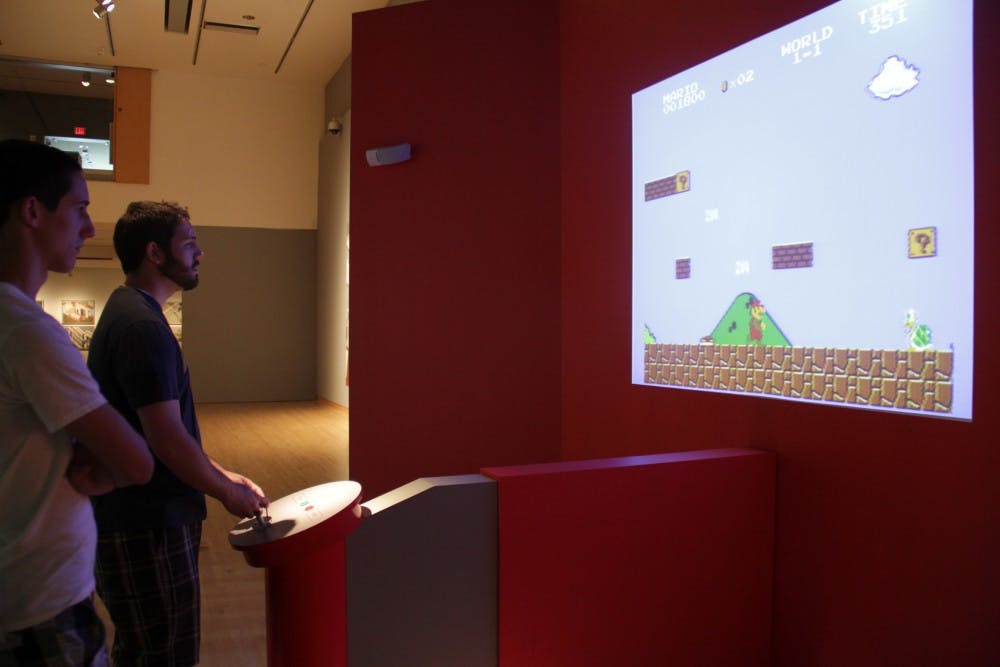 At Saturday’s Art of Video Games exhibit at the Phoenix Art Museum, Sarah Melcher, 16, models as Temari from the anime series Naruto Shippuden and allows patrons such as ASU alumnus Chris Ballew to draw her. (Photo by Shawn Raymundo)
At Saturday’s Art of Video Games exhibit at the Phoenix Art Museum, Sarah Melcher, 16, models as Temari from the anime series Naruto Shippuden and allows patrons such as ASU alumnus Chris Ballew to draw her. (Photo by Shawn Raymundo)The Phoenix Art Museum’s Great Hall buzzed with energy as children and parents sat down to board games Saturday.
The pieces were created in the West campus game design courses taught by Theresa Devine, a professor at the New College of Interdisciplinary Arts and Sciences.
Devine discovered that the traveling Smithsonian exhibit was coming to Phoenix and contacted the museum. Curators from the museum hand-picked 10 of 20 games proposed by Devine.
“I thought at first it would just be a panel or a lecture or something, and they wanted a more interactive experience,” Devine said.
Devine, who has taught game design for many years, said she splits the course into two parts. In the first half, students create board games. In the second half, they create a video game. The board game serves as a prototype for the video game.
The students’ games the museum selected range in topics. Some games focus on purgatory and others on survival skills during war. Devine encouraged students to look beyond clichés and normal play concepts.
Applied computing senior Sam Miller based the premise of his game on “Hop-Frog,” a short story by Edgar Allan Poe.
“It’s a story of a physically disabled midget that’s named Hop-Frog by the king that rules over him," Miller said. "He creates a plot to get revenge, kill the king and flee to safety and so I kind of wanted to bring in the frustration of being Hop-Frog into the game."
Miller is working on another game in his free time and credits Devine’s class as the impetus behind seriously pursuing game design.
Applied computing senior Ever Rivas created “The Battlefront,” a war game that focuses on "strategy building," for Devine’s class. He said he hoped visitors would take away that games can be educational and promote respectable values.
“It was important for me to get this out there so people could really look at it and realize games aren’t as violent as they think they are,” Rivas said. “They don’t teach the negativity that most people think they do.”
Integrated studies senior Doni Shepard wanted to create a game that incorporated her psychology background. Although she was not as influenced by gaming as other students, she found a way to translate what she knew with game design.
She created a trivia-based game called "Simplicity." Players move around a board with the seven deadly sins on it and attempt to release what bothers most people in life through release cards.
“I intend to become an art therapist, but this type of thing—games are something that can be incorporated depending on whoever you’re working with and creating something will translate wherever I go,” Shepard said.
 Lucas Corbitt, 16, watches his brother, biochemistry sophomore Michael Corbitt, play Super Mario Bros. at the Art of Video Games exhibit at the Phoenix Art Museum Saturday afternoon. (photo by Shawn Raymundo)
Lucas Corbitt, 16, watches his brother, biochemistry sophomore Michael Corbitt, play Super Mario Bros. at the Art of Video Games exhibit at the Phoenix Art Museum Saturday afternoon. (photo by Shawn Raymundo)English senior Iris Nakiso, creator of the board game “Purgatory”, recognized Devine’s dedication in transitioning games to art but more importantly in creating a dialogue between people.
“It’s not always about the game itself, but it’s the people who created it and brought it forward to everyone else," she said. "That’s what constitutes interaction and learning."
Reach the reporter at cncalde1@asu.edu or follow her on Twitter @katie_calderon




